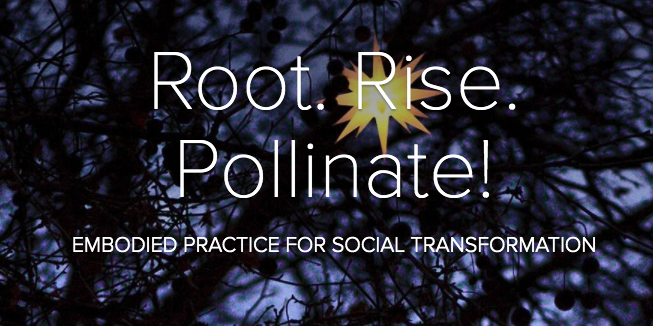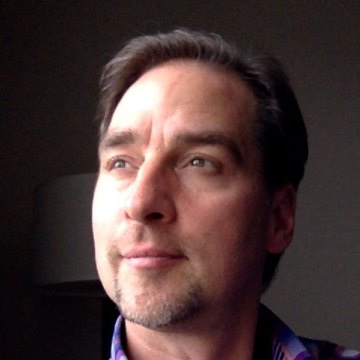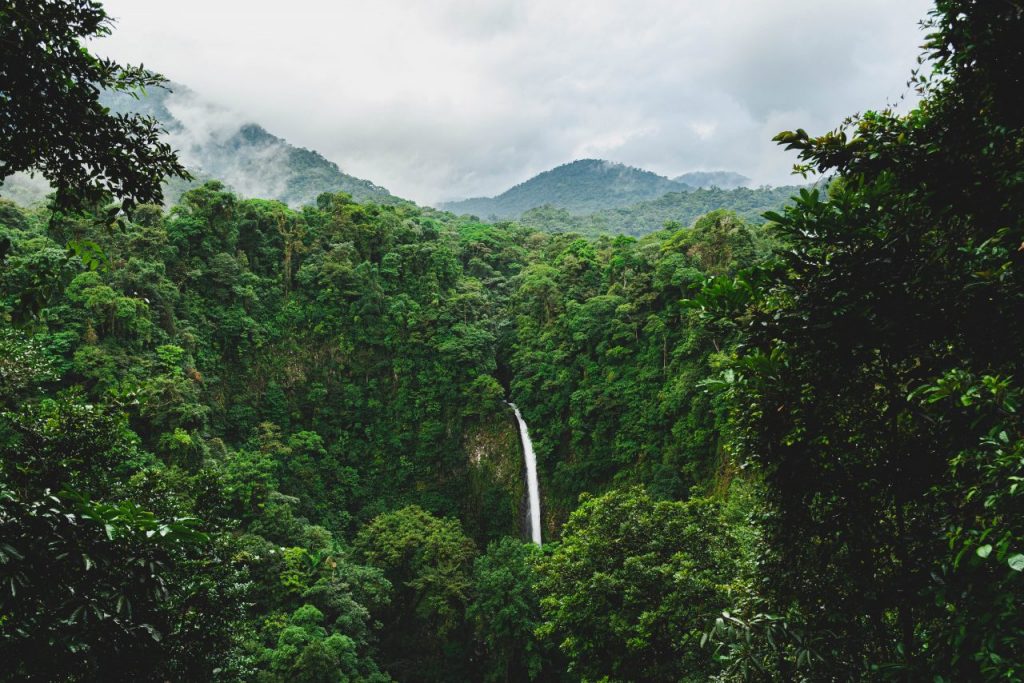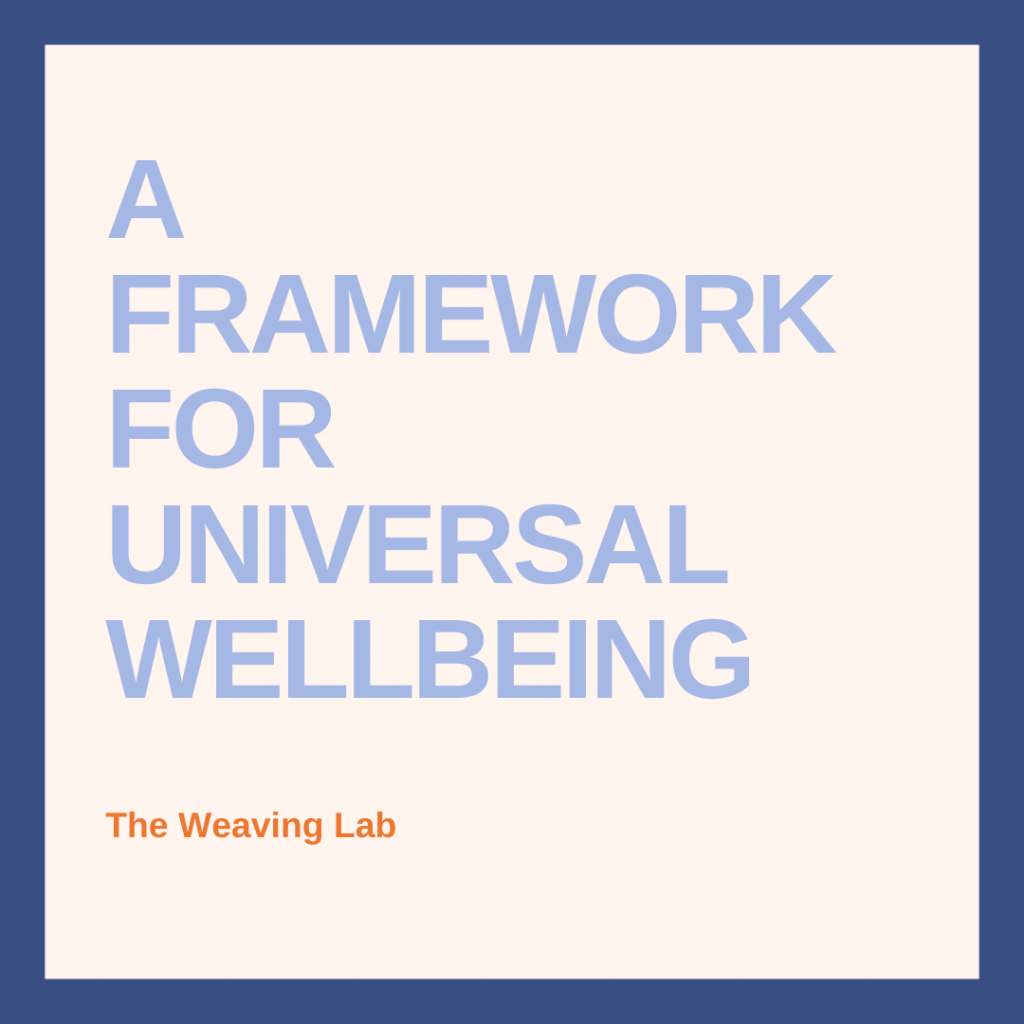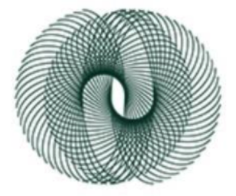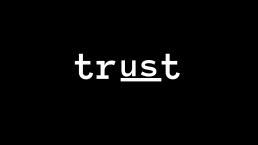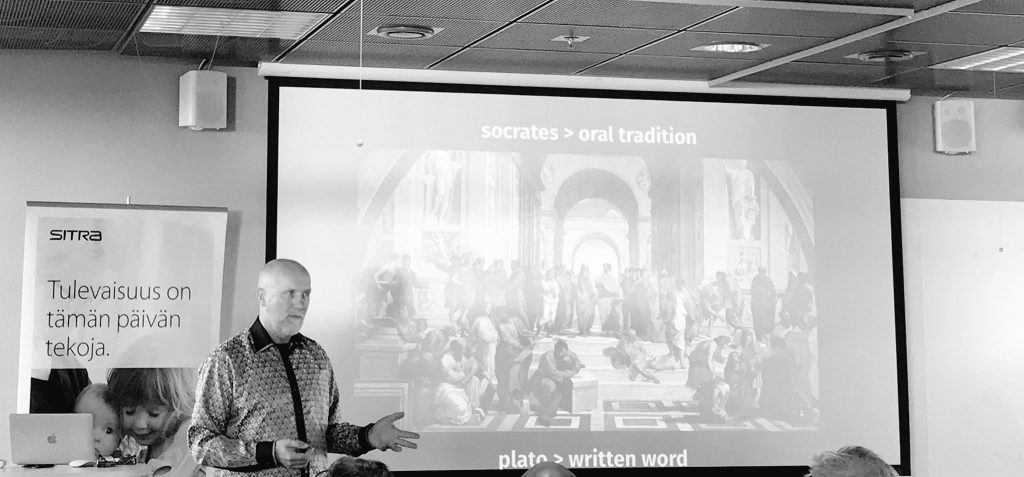Intergenerational Practice and Space
This week, Network Weaver is excited to share a 3-part series by Root. Rise. Pollinate! on fostering connection in virtual space. The series was originally published earlier this year at The Reverb.
How we can create beautiful connections and discoveries across generations.
Posts one and two of this series focused on setting virtual space and intentionally cultivating and sustaining the kind of energy required to be in non-physical space together. In this final post of the series, we center the “who” — the mix of people to invite into and be in space with, especially in light of the isolation that’s come with observing COVID-19 physical distancing safety measures. Here we lift up the beauty, imperative for, and power of intergenerational space.
What’s Possible When Young, Middling, and Elders Come Together?
Dominant narratives (including in organizing) often pit young versus old against each other, and render elders as spent, disposable, or out of touch. Our movements too often sideline both younger and older generations, and seldom do we meet. Yet many of us who’ve sat down for conversation or play with elders or those who are younger than us, including babies, know and relish the beautiful connections and discoveries that we can experience in encounters across generations.
We, present day dwellers of Mother Earth are here because of, and through our ancestors, just as some day our descendants will be here because of and through us.
We learn from and listen to messages from the past in order to seed the future, and we too must draw on and commune with all of us — young, old, and in-between — both human and non-human beings.
As you design your virtual space and identify different community members to share breath, ritual, and movement practices, pay attention to the mix, in terms of age, of who gets to hold space. You could pair the youngest and oldest members of your community to share old or new practices that they create together. Or perhaps you could have an intergenerational mix of people in breakout rooms together for intimate conversations and mutual learning. Importantly for learning and deepening relationship, make space for the virtual community to then share what they have heard from each other, what challenged them, what they are grateful for, and what they would like to cultivate and take beyond the virtual space with them. And remember to invite community members to acknowledge, express appreciations, and create opportunities to continue to connect with each other beyond the virtual space.
These physically distanced times have created an opportunity for us to cultivate and create sacred intergenerational relationships that we rarely get in organizing and “movement” spaces.
As we close out this series of posts, we also share with you the power and connection that comes out of being intentional in how you close your virtual space. The beginning is just as important as the end as the end is in fact another new beginning.
Just as we invited you to open and arrive with ritual and breath practice, we invite you to have in place ways in which you bring your space to close. Options include:
- Inviting community members to share short reflections, gratitude, a song, or a poem
- Physically replicate hugging and sharing an embrace with each other
- Rubbing your hands together to generate heat and move energy, then sharing that out by holding your palms out to community members on the other side of the screen, and then receiving the heat and energy to hug ourselves
We hope you enjoyed this series and would love to hear about other rituals, breath, and movement practices that you’re trying out or have found particularly potent in your own virtual gatherings.
Read post 1 HERE and post 2 HERE
Originally published April 16, 2021 at The Reverb.
Root, Rise, Pollinate! is an experiment that aims to catalyze and nurture a transnational community of feminist human rights advancers, organizers and movement builders using embodied practice for social transformation.
PLEASE DONATE to help Network Weaver continue in it’s mission to offer free support and resources to networks worldwide.
Embodied Practice
This week, Network Weaver is excited to share a 3-part series by Root. Rise. Pollinate! on fostering connection in virtual space. The series was originally published earlier this year at The Reverb.
How to bring movement practice into virtual space to foster connection with our bodies’ wisdom
In our first post we shared the importance of breath practice and ritual for deep connection in virtual space and offered rituals grounded in the elements of air, water, and fire. As we share the next practice on embodiment, we’d like to invite you to consider how all elements, air, water, fire, and earth live within each of us.
How do we embody each element at different times including times of upheaval and possibility for interdependence, deep connection, and love in a rapidly changing world like now?
Embodying The Change We Seek
Movement requires movement. The simple truth of this statement is particularly important during these times of physical separation, especially when we sequester ourselves in our homes and lie or sit in one position for long periods of time. Perhaps we are in front of screens for work or to indulge in whatever’s on offer from the multitude of streaming services that keep popping up.
While this time of COVID-19 is a particular point in our lives, around the world, over time, many of our people have become disembodied as a result of the privilege given to intellectual knowledge and grind culture over more holistic ways of knowing and being. This has led to individual and collective burnout, and even trauma. Even changemakers now ground much of our work in logic models, pages upon pages of strategy, theory, and deep analysis. We lead with our heads, not our hearts and bodies, even though we often already know in our bodies what is most important. In leading with our heads, we lose touch with our bodies sometimes to the point of breakdown and exhaustion.
When we are disembodied, it can be hard for us to tap into what the change we seek would feel like.
If we are disconnected from our bodies, how do we know how and where feelings of joy and inspiration show up in our bodies?
How do we tap into the inner wisdom that tells us when we need to pivot into something more life-giving and sustainable? How well do we connect to the hearts, minds and bodies of ourselves and fellow beings?
Therein lies the importance of body-based work so that as we reconnect with and listen to our bodies, we can draw on and be one with the delicate balance of earth, water, air, and fire that lives within us and is required for the liberated, sustainable, and thriving world that so many of us work tirelessly for.
So how might you bring movement practice into virtual space to foster connection?
You can draw on and invite your community members to share practices that they already know and engage in like somatics, tai ji, and yoga. As you practice, be sure to move with your breath, being conscious about the physical actions you take with each inhale and exhale.
Ultimately, starting virtual gatherings with practices — like (breathing through) movement — can help bring everyone’s bodies, minds, and spirits into alignment, enabling deeper conversations. Starting with and in our bodies allows us to be more present with each other and experience a sense of intimacy, even across distance, time, and experience.
An Invitation
Consider this: how might physical movement coupled with breath support you and your connection to those you care about? Who might you invite to practice with you? Next time we’ll touch on the practice and importance of fostering intergenerational space.
Thank you for continuing to journey with us.
Read post 1 HERE and post 3 HERE.
Originally published March 11, 2021 at The Reverb.
Root, Rise, Pollinate! is an experiment that aims to catalyze and nurture a transnational community of feminist human rights advancers, organizers and movement builders using embodied practice for social transformation.
PLEASE DONATE to help Network Weaver continue in it’s mission to offer free support and resources to networks worldwide.
Taking a Virtual Breath
This week, Network Weaver is excited to share a 3-part series by Root. Rise. Pollinate! on fostering connection in virtual space. The series was originally published earlier this year at The Reverb.
How shared practices can create depth and connection despite physical separation
As we settle into our second year of physical separation wrought by the COVID-19 pandemic, our sense and practice of community and connection is stretched. We continue to maintain physical separation as an act of safety and care for each other for the foreseeable future.
The experience of physical separation is not only an experience between each other, but also within ourselves, as individuals.
If you stop and pay attention for a moment, and look away from your screen, can you locate where your breath currently sits? Is it in your throat, your chest, your belly, somewhere else?
When was the last time you intentionally noticed how your body moves: perhaps danced, stretched luxuriantly, or massaged yourself? When was the last time you listened for birdsong or paid attention to the ground holding you up? Or perhaps the physicality of all this is too much to bear?
In this time, many of us have the opportunity to deepen our practices of care, connection and community, bridging distance across time and space. We still get to support, celebrate, and be with each other albeit in virtual space. We get to be even more aware of why and how we do this.
Practices of connection with self and community are essential for us to harness and nurture the kind of energy needed not only to get us through hardship but also to imagine and bring forth futures of thriving, interdependence, and wholeness.
Over the past year Root. Rise. Pollinate! experimented with how to cultivate care, connection and community with feminist change makers around the world. We are going to share the virtual connection practices we developed in a series of three posts over the next few weeks. These practices were especially meaningful because they helped create a real sense of intimacy, care and depth even though we were separated physically by time, space and the pandemic. This was possible because the practices hinged on building authentic relationships, exchange, and building on each other’s wisdom.
The first post in our series focuses on how to open and set the space through breath practice and ritual. Subsequent posts will focus on embodied practice and intergenerational practice. We hope these offerings support you in this time of continued physical separation.
Setting the Scene: Preparing to be in Virtual Space
Even though we are limited to virtual rooms, it is still possible for us to “set the space” and create conditions for your group to experience authentic connection.
The most important thing is our attention and awareness. Before each session, invite community members to be in — and to the extent possible — protect a comfortable space with few distractions or disruptions for the duration of your time together. As participants arrive, play music whose energy captures how you want the community to feel during and after each session. Also invite community members to be and stay on camera if possible and to let go of any (assumed) judgement of their physical space or appearance. This preparation is particularly important as it creates the opportunity to arrive and stay in space with more ease.
Virtual gatherings make it so we miss out on some of the cues that we’d typically rely on in-person. How do we set and read energy in the ‘room’? What new cues do we need to tune into where body language subtleties are lost? How might we arrive together sans hugs, handshakes, and kisses? We propose setting and entering space with and through breath practice and ritual.
The Power of Breathing Together
Some research findings suggest that choir members, through synchronizing their breath and voices when singing, also synchronize their heartbeats.
This kind of connection, heart to heart, is important when setting energy that fosters connection for community building in virtual space.
Guided breath practice, which lasts for 10–15 minutes allows community members to:
- get out of their heads and release — at least for a little while — from whatever they have been doing or thinking prior to the session, and
- be with their individual breath as part of a collective, breathing organism
This practice may take the form of the group participating in five rounds of a five-breath sequence together, with accompanying physical movement. This works best when one person leads and provides cues for the group.

Breath (and physical movement) Practice
Coupling the breathing with physical movement ensures that community members arrive within themselves, their own bodies, as they arrive with the community as well.
Palms facing up, interlace your fingers just below your belly button.
Inhaling
- As you inhale slowly, move your arms up
- As you get to chest level, rotate your palms (face down then quickly face up again) to allow you to bring your interlaced palms above your head with ease. Pay attention to the sensations in your shoulders. If you have any tightness, lower your arms to the level at which the tightness releases.
Exhaling:
- Turn your upturned interlaced palms to face down
- Slowly exhale as you bring your arms back to just below your belly button. Aim for your exhale to be longer than your inhale
This completes a round of breath.
- Round one: inhale in silence, exhale in silence (five times)
- Round two: inhale in silence, exhale with a hum (five times)
- Round three: inhale in silence, exhaling with one vowel — a (ah), e (eh), i (ee), o (oh), u (oo) — on each breath
- Round four: inhaling in silence, exhaling with a hum (five times)
- Round five: inhaling in silence, exhaling in silence (five times)
Arrival breath-work is about opening and holding space for community members’ hearts to connect and beat as one in preparation for whatever conversations or work that lies ahead.
Once the community is breathing as one, then you can move into shared ritual in order to continue to deepen connection.
Ritual: Setting Space and Coming to Center Together
Rituals have long been part of human existence across different cultures bringing community together in times of joy and celebration, in times of grief and mourning, to commune with the spirit realm, to assuage anxiety or prepare us for big undertakings — to get us through life. In an ever-busy world, where many peoples have lost touch with ritual, particularly communal rituals, the slowing down, the great pause brought on by COVID-19 created an opportunity to practice and reëngage with, or perhaps create new rituals.
We rooted in rituals and conscious practices to bring the group together in a focused, energized way. In light of the COVID-19 pandemic, rituals for self-care and healing are essential as are rituals and practices that deepen our sense of spirit-rootedness and collective thriving. Rituals may be rooted in a tradition or culture, or be co-created in groups. Below we share two rituals around water and fire.
Creating a Community Water Font
Tewa elder, Kathy Sanchez from San Ildefonso Pueblo in New Mexico modified an in-person water ritual for virtual space, inviting the community to acknowledge, honor, and commune with water as a life-giving and life sustaining source.
Invite community members to bring water into space in a ceramic, earthenware, or similar vessel forged from living material.
Participants name the source of their water — river, stream, watershed, etc. and share reflections on water in their lives including how it heals and lives in and through each community member. Community members then imagine pouring, and therefore mixing their water, into a vessel where many waters flow as one.
Building a Communal Fire
Invite community members to bring a candle and matches or lighter into space. At a designated time, those leading the space invite community members to each light their candles and share their internal wisdom about how this element — and indeed all elements — show up in our external and internal lives as life-giving and sometimes destructive forces as we build towards thriving communities and futures.
Rituals such as these enable community members to thoughtfully bring their individual experience into the community as part of building a collective ritual, which they can carry beyond virtual space.
An Invitation
As we close out this post, we invite you to practice some of what we’ve shared — perhaps first with yourself, and then with a friend or colleague. You can begin by just taking one breath, consciously inhaling and then exhaling. Consider, what difference might it make to our collective futures if we regularly synchronized our heartbeats? Stay tuned for the next offering on embodied practice.
Read post 2 HERE and post 3 HERE.
Originally published March 4, 2021 at The Reverb.
Root, Rise, Pollinate! is an experiment that aims to catalyze and nurture a transnational community of feminist human rights advancers, organizers and movement builders using embodied practice for social transformation.
PLEASE DONATE to help Network Weaver continue in it’s mission to offer free support and resources to networks worldwide.
How to build your network skills and approaches
Collective Mind is on a mission – to equip network leaders and managers with the skills and approaches to make their networks effective and impactful.
We exist because we believe in the power of networks to foster collective action, especially in support of systems change and addressing hard, complex problems. We also know from our firsthand experience that operating within a network environment requires different strategies, approaches, skills, and tools than those we use in more traditional organizations.
In our discussions with network leaders and managers, they’ve told us that they seek support, connections, and tools. Previous research told us that network managers don’t always come to their roles with network experience and that limited professional development opportunities exist to improve understanding and build skills.
Our goal is to fill these gaps by creating learning opportunities for network practitioners to improve their practice.
Collective Mind’s Virtual Summer Camp is a major opportunity to build your skills and approaches, with thoughtful, comprehensive frameworks to understand networks, access to experts and in-depth discussions on network topics, and peer connections through learning circles and networking opportunities.
Virtual Summer Camp runs over three weeks starting July 12th. The schedule is designed to accommodate busy schedules and workloads, and campers can choose to join the first two core weeks or all three weeks. Building on the experience of our inaugural camp in 2020, this year’s camp promises to be an incredible opportunity for participants to learn, connect, and improve their practice.
Collective Mind seeks to build the efficiency, effectiveness, and impact of networks and the people who work for and with them. We believe that the way to solve the world’s most complex problems is through collective action – and that networks, in the ways that they organize people and organizations around a shared purpose, are the fit-for-purpose organizational model to harness resources, views, strengths, and assets to achieve that shared purpose.
PLEASE DONATE to help Network Weaver continue in it’s mission to offer free support and resources to networks worldwide.
Power dynamics: A systemic inquiry
Why this article? Purpose and position
The word power keeps popping up wherever I turn. Through my ten years of doing my doctorate action research it was all over my notes and reflections. I kept pushing it out of what I was writing about and feeling scared to even go there as if the power of it itself was too much to face or to look at, as if it was just too complex and unknown. In the end I could not ignore the question and did reflect on what it meant for the work I had been doing. I concluded that the field of systems change did need to really integrate it more into its work. Fast forward a couple of years and the question kept on slapping me in the face, not literally but in the questioning of who you choose to facilitate a session, how you frame the work, make decisions and so forth — saying to me — come one you said it was important to what the hell are you doing about it!
This article therefore is trying to pull together some of the thread of the last four or five years of looking at the journey so far and what I have learnt. I have put off publishing this for eighteen months as if the final answer or way to present it will come, but that I also realise is a putting off — so here is some of the messy journey of stumbling around in the dark.
This article there has a few elements to it.
- Firstly how the issue of power relates to the systemic sustainability challenges we are facing — from climate change, deep inequalities that through the mirror that is our time in Covid has been seen even more acutely and how we might see the way they interrelate and are part of the same issues.
- Secondly exploring the concept of power and how it relates to systems change;
- Thirdly, looking at some of the insights about what makes up the dynamics of power, that are based in both our histories, and wider context as well as how that manifests in us individually and needs work all levels;
- Finally starting to explore some framings of the strategies we might take to work with power.
I am trying to explore this topic from a systemic perspective, by which I mean exploring the dynamics and deeper rooted mental models that affect them and how they play out in the world. In a previous article I explored the multi-dimensional elements of power which I will not repeat here.
I also want to acknowledge that I am a white woman born and living in the UK, I am middle class, went to a private school and have a postgraduate education. I am a Director of a charity and have a comfortable life. I have a huge amount of privilege, rank or social and psychological power. Over the last couple of years I have realised how much of this I still need to understand and do. I am still on a massive journey to explore what this means for me, my work and those I work with and most importantly how we best act on this exploration. I acknowledge that this writing in and of itself addresses the issue through my own lens of knowledge and privilege, intellectualising it, exploring it through tools and approaches that I use. And yet this is the only way I know how to unravel what I have been experiencing and the challenges that we see. I am trying to live life through inquiry, to explore what is emerging in front of me, to actively lean into what is needed, to learn from the experiences, to read and learn from ideas that are out there and to ask myself how might we enact these in practice, for myself, for the work that we do and for the world.
So I invite you readers to enter into this journey of exploring with me and am interested in your own reflections and feedback.
Why power is a systemic challenge; where does it show up and why is it a problem?
There might be many ways to understand this dynamic, we could start with questions of poverty, inequality and all social and environmental challenges. For example exploring the issues of climate justice demonstrates and shows the effects of our current frame of power. The causes of climate change have predominantly been created by those who have used and burnt carbon for their accumulation of wealth and the improvement of their lives. This meant that they drove their dominance in the global economy, from the industrial revolution to the perpetuation of colonialism. Whilst the effects of climate breakdown are being more acutely felt where the most vulnerable live, whose development and ways of life have been hampered and repressed by power dynamics in the past. It raises questions about who has and is benefiting, where is the burden and how can we move to a more equitable and fair world? How might we transition is a way that is just and fair (a just transition)?
At the heart of these issues is dominance — of one society, nation, peoples — where their policies and practices acquire control over another — through literal means — from slavery, use of resources, exploitation, occupying land. It starts from a place of difference, but is acted on from a sense of superiority, exemplified through racism and other oppressive behaviour across all forms of intersection.
The current exploitation of our planet and people are manifest from power dynamics that have been perpetuated and continue to be so in all our systems. Many of the historical drivers of our ecological unsustainability — of extraction, consumption, capitalism — are the other side of the coin of the issues of colonialism, white supremacy, racism. Understanding power therefore might help unlock how we might transition to a world that is not only sustainable but just and regenerative that is has the capacity to keep distributing resources in a fair way. We in the sustainability field can no longer ignore these issues.
This diagram seeks to show how these different ideas and processes relate, how they are all part of the same dynamic. There are historical drivers and trends that have created the current world, a way to frame old power (which I will get to shortly). These manifest in issues that we see today in the world such as racism, under which are structural issues of inequality and privilege. I am proposing that these are all part of deeper power dynamics (that are informed by our perspectives). We are looking to understand how we transition to a future that is equitable and just and has power dynamics (new power) that are fluid, plural and understand life as a process.
How might we understand the concept of power?
Power is a contested term. The way we often use the word it assumes that it is about the power one thing has over another, be it explicit, or covert or unseen.
This first framing of power places it as a process of othering, by which we make others not the same as us, the noticing of difference and in the same breath we place value judgements of who is better, what is better and who has more power than others. This in turn starts to become embedded in our structures and our consciousness, so that structural racism or white supremacy exist.
Power as such though is simply the energy exchange between two things and so a second framing — I would argue a systemic one — starts to look at power through the eyes of our relationships, through the web of societies’ capillaries — that permeate the fabric of our existence. As such it also can be a motivator for what we do and how we do things, and has such power lies within us and can give us a sense of agency to change ourselves and things around us.
“We have the power over our own story” (Rushdie, 1991)
Power as such is not a static concept, it changes, not just who has it but also how we understand it through the course of history. Power operates within a perspective, worldview or paradigm. How we see power affects how we act with, on or from power. So it is vitally important to understand the position and perspective that we are coming from in order to understand power. For this article I will only use two — that of the current or old power of dominance and power over and that of the emerging new power — one that sees it more as the relational systemic flow.
How do we transition from a dynamic between us, now embedded in our structures, from one that has certain people, groups over others and which results in great exploitation of resources to one where we are living with just, fluid, plural, diverse relationships and where people have the sense of agency to also author their own lives?
Power and systems change
If we define systems change as the emergence of a new pattern of organising and power as a relational dynamic not a given state; then changing systems is all about also shifting power dynamics. Then in order to change systems and power dynamics we need to change the nature of our relationships and our ways of relating. As started to describe above, if we are to address issues of inequality, climate change, racism and all forms of social and environmental issues then addressing power dynamics is central to them all.
The current power model — or the pattern of how the system is structured is through coercive hierarchy and structures that are based in dominance, of power over and the relational dynamics we need to move towards is one that is systemic — by that I mean a way of living that recognises that life is change that we live and work in dynamics and fluidity whilst also recognising that this needs to be done justly.
There are many ways we relate in society, where we have created societal structures around — each of which might be a route into addressing power dynamics. In society some of these foundational structures are:
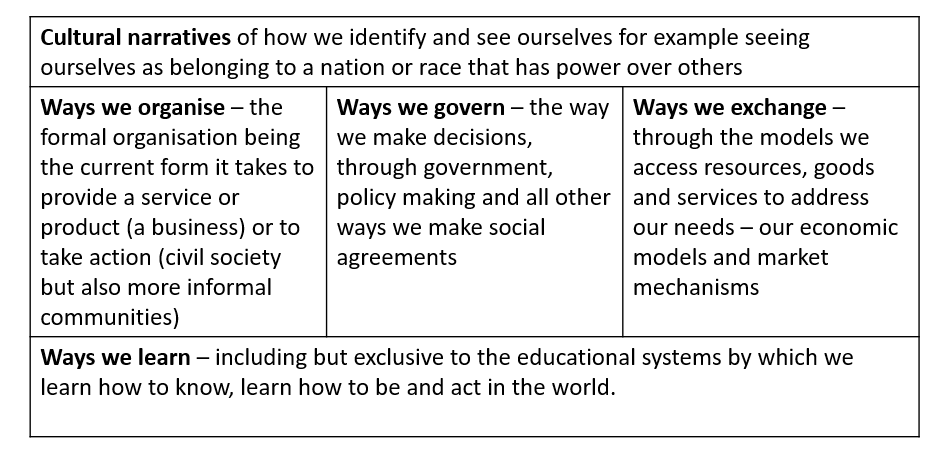
[A note — not all power over is exploitative, for example in many hierarchical organisations, however if we want to address power that is then we also need to model what new relationships of power look like, so as to offer the potential for more healthy and flourishing relationships.]
What questions does it raise?
If I am saying power is an underlying dynamic and my overall inquiry question is — How might we cultivate systemic change? Then the question(s) relating to this exploration might be:
How might we transform society, its power dynamics, from the power over model that permeates today to a just form of relating and organising that is systemic?
- How might we change the nature of our relationships?
- How do we cultivate and be in relationship?
- Who do we work with and how?
What does this mean for us personally? In the projects that we do? What does it mean at how we transform society?
Insights in to what affects power dynamics
After exploring power as an idea and more importantly in practice over the last few years here are some insights into the dynamics of power from these experiences.
Although power is relational, we as individuals also have different positions in the web of social relationships. Having an awareness of your privilege and positionality and therefore any assumptions and bias you bring to any given situation is therefore critical to understanding power.
As we grow in relationships we do not grow straight and perfect. Different experiences and traumas, where unfair use of physical, psychological or social power has been used against you (Mindell, 2014), in our past determine how we grow from the inside out. These traumas are like knots or different shapes that develop in a tree that will continue to determine how it will grow and relate to others. These might be developed from how we are parented to the culture and society we grow within. This inner world, our psychology, plays out in our relationships and therefore can (re)create power dynamics that can perpetuate harm or injustices.
Due to our different awareness's, positions and life experiences we are all on different journeys of both understanding but also being impacted by dynamics of power. I have used the metaphor of yoga to help exemplify this. When we start doing yoga we have only a certain amount of flexibility, we are only so open. The way yoga is practiced is you stretch and move to the edge of what you can do, push in slightly but not too far and then relax, you transcend and integrate. You keep practicing and over time you open up to new movements and ways of doing things. This is the same for our addressing power, everyone has different levels of fluidity, openness, flexibility and ability to deal with these questions. This does not mean we cannot go on a more intensive yoga retreat or practice daily to get better practitioners.
Understanding our position and traumas requires inner work, that is to say working on the things that activate us or trigger us — that is something that might cause us to feel emotional not by the current experience but because it takes you back to something else in your past — that stop or hinders us from moving forward on our journey. Using the yoga metaphor again, if we had a bad angle injury it would affect what moves we could do. Our development of our psyche is the same and affects how we are in relationships, as facilitators and practitioners. Inner work aims to work on these issues and help us move with fluidity and openness.
The environment we find ourselves is also extremely important. Unsafe environments that we are not prepared for can cause more harm than good, be it an organisational or workshop setting. However we also need spaces that provide the conditions for bravery to work with issues that are uncomfortable and hard to address as this is not an easy journey. For this we need facilitators.
If we see facilitators role as bringing awareness to the world, sensing and working with people and their interactions, relationships and other dimensions so as to bring forward what the world needs of us we may look at the practice of “sitting in the fire” to get used to this uncomfortableness.
As a facilitator these environments can be supported by showing both vulnerability, the openness you can display in your own learning to model opening up for others as well as knowing your boundaries and taking accountability for your actions.
Finally all power dynamics are fractals, that is to say that a pattern that is happening at a smaller level will be happening at a wider scale and vice versa. For example a dynamic that is happening between two people might also be seen within the team and then again within a wider network or society as a whole. Therefore if there is a pattern of power that has not been addressed by a facilitator team it will start to play out into the workshop and equally where an organisation is not addressing power issues themselves they are unlikely able to be addressing it in the wider systems they are trying to change.
What does this mean for the work that we do?
So if these dynamics and patterns are playing out at all scales what might some (not all) strategies for how we address the way that we might relate?
Minimise power-over
I am going to start with this framing as I feel it is the hardest one to deal with. Coming from a position of power and privilege it is critical that this does not get side-lined. Donella Meadows in her paper — Leverage points: places to intervene in a system describe how often address a dynamic by looking at solving the problem rather than looking at the dynamic that is perpetuating it. For example anti poverty programmes are weak negative feedback loops, trying to balance out the stronger positive feedback loop of a systems that brings more and more “success to the successful”. In terms of relational dynamics it is far more effective to weaken the positive loops — in this case minimising power-over relationships.
I will risk repeating myself and highlighting the two insights from above and how we must also look at them as strategies for change
- Position awareness — individually, organisationally and at any scale. Acknowledge the power and privileges we have, for example what knowledge we are privileging. Be prepared to be open about it, find ways to talk about it, be humble with what you are doing — practice vulnerability.
- Understand and deal with our triggers and traumas — so that we start the learning journey of not creating harm (again at all levels). Become really comfortable with uncertainty, being uncomfortable so you can turn towards and be centred in challenging situations.
- Be open to having difficult conversations
- Practice letting go — what would it mean for the organisation to not exist, to write its own exit strategy? What if you personally were to live on a lower income, with less consumption? This also means getting out of the way of others.
- Transition power and resources — This means working with those in power and hold decisions over the resources to use their power to shift where and how decisions get made. For example funders hold a lot of power in change systems or policy makers across society.
- It sometimes takes a generation to shift a system as mind-sets and power shift. Consider what the trajectory is for people giving up or more shifting their (supposed) power, support shifts in identity, their sense of who they are in the world. Help them become enablers, elders and play a role with those who have more power then them as part of the transitional process. What are the rituals and ways we might celebrate, acknowledge the journey.
- Change the narrative that helps build this perspective shift, whilst also recognising that language is a form of knowledge and power. This might require doing discourse analysis to support reframing.
- People cannot be coerced, invite people in to develop the collective mandate — start using participatory methods to do this (see next section). I am not however saying that there is not a role for calling out or campaigning where harmful practices are pointed out however we do need to understand them in an ecosystem of changing relationships.
Set the conditions and enable power-with
- If you are facilitating these processes really model behaviour of being open to what might emerge and the way forward. Like above — be acutely aware of your power as holding a space, ensure that you do your inner work.
- Use the power that you do have to demonstrate and use participatory methods for decision making, working together and building coalitions. This means setting the container for working and relating, through being clear about mandates, roles and responsibilities and not assuming everyone knows how to work from the get go. Ensure there is participation in the production of knowledge and learning.
- Creating safe or brave spaces for people to work together. This might be preparing people to be able to be in the room together, investing time so that new ways of relating can be found. Change can only happen at the speed of trust.
- Transparency is critical for this, allowing the process to be seen and be open to be called to account and criticism — actively inviting in alternative views, seeking wisdom in the minority to improve the decisions and processes.
- Create liberating structures, new ways of organising, regenerative cultures and rules that enable self-organisation — there are different examples and literature on these different methods — for example Re-inventing organisations.
Enable power from with-in
Much of this is also a repetition of what has been said above — supporting inner work, addressing trauma and triggers and ensuring resources are put into this work.
- Place high value on lived experience as supposed to learnt experience — which usually manifests in approaches to learning and capacity building that are transactional, delivered to people not with. Value the learning process over the knowledge accumulation.
- Follow the principle with not on. An example of this might be not creating personas of different views and perspectives but actively bringing real people into design and futures processes.
- Work is needed in the liminal spaces, find the people who can be the bridges and give them resources both time, money and safe spaces to support the transition.
- Create transitional decision making forms — for example a shadow board, to build agency to transition power
- Devolve decision making — through the above strategies ensure that the decision happens closest to the impact
- Really understand the process of personal change and what that means societally– and recognise that everyone has their own stretch and time requirements
This list of actions are by no means exhaustive, they also do not address some of the actions needed for addressing some of the specific issues such as racism, but its aim is to start to think about relational strategies that might be beneficial to all these issues. Please do also share with us others you might have and what is missing..
So where does this leave me?
I am still struggling with the process of shifting the dynamics of power on a daily basis, from every interaction I have as a leader, teacher, facilitator, director, white UK woman, parent even, trying to bring awareness to what I am doing. How I have to both step up, use my power, stand up for what I believe in and set the conditions for others and in the same breath step back and get the hell out of the way and just shut up!
How I still feel rage or anger for people not doing enough and how it bubbles over and out as I don’t know where to always put those feeling and yet trying to heed my own insights that its a journey and you cannot undo centuries if not millennia of harm and oppression that has existed in the one moment you have in front of you. And yet you try and do something and then you know every action is just not quite enough or good enough and again you find yourself fumbling around in the dark.
How I also know there is still so much that I do not see, so much of our unconscious so much of that we are all still playing the game of the current system and thinking that we can somehow change it, that its forces and dynamics are still as yet unknown. How we are complicit every day in its powers.
And so one promise I will try and commit to myself is that I will not keep ignoring the calling of this question both in my own learning and in my practice and that of those I work with. That all I do know is that I need to keep coming back to it as in itself it also has an illusive enticing power of intrigue to the flow of life itself and how it has both caused great harm and yet if relationships are also what gives us great joy and a sense of flourishing it also has the potential to bring healing.
Many of the ideas in this article have been influenced by my reading and training in Processwork — including the work of Sitting in the Fire by Mindell. I am also grateful for those those I have been co-inquiring with over the years my colleagues, co-inquirers and funders, at Forum for the Future, School of System Change, Living Change, Boundless Roots and Lankelly Chase Foundation and New Girls Network.
Originally published at School of System Change
Director School of System Change, Forum for the Future
@annasquestions
Anna is passionate about designing and facilitating systems change programmes that support people, communities and organisations to transform their practice.
PLEASE DONATE to help Network Weaver continue in it’s mission to offer free support and resources to networks worldwide.
Thinking Like an Octopus (and With a Collaborative Heart): Evolving and Interlocking Networks
“You’ve got to keep asserting the complexity and the originality of life, and the multiplicity of it, and the facets of it.”
Toni Morrison
A network that I have been a part of for a number of years is seeing the emergent proliferation and strengthening of other related networks (some more adjacent than others) in its shared geographic and issue spaces. While this is welcomed overall, and sets up the potential for a more robust movement network and core-periphery structure (see image below), there are also some discussions within the network about how this proliferation constitutes an opportunity versus a looming threat or conflict.
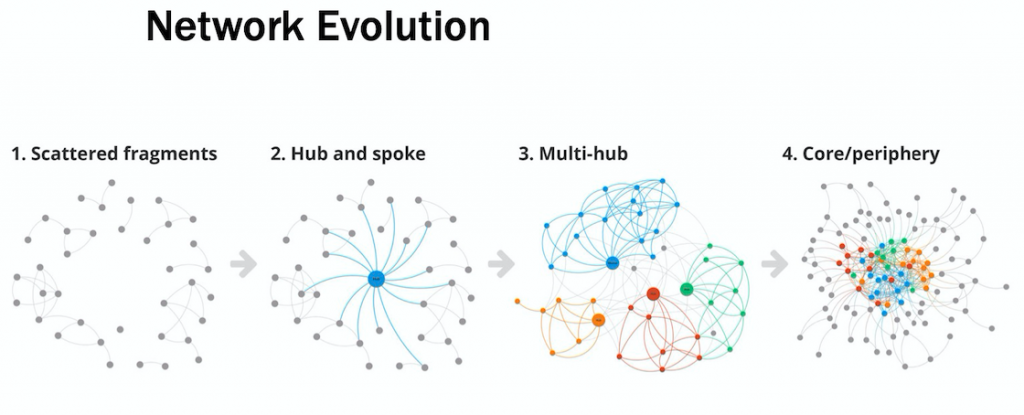
There is plenty being written about the power of collaboration to solve complex problems and shift undesirable patterns, and one of the persistent barriers to collaboration is the default competitive and protective instinct found in individuals and groups. There are good and long-standing evolutionary reasons for “watching out for number one,” so this impulse can be fairly baked in. And there are also good reasons for understanding and leaning into “collaborative advantage” (see, for example, the work of evolutionary biologist David Sloan Wilson on multi-level selection).
“One step is to recognize that ‘ideologies extolling individualism, competition, untrammeled free markets, and conversely, disparaging cooperation and equality’ (as Turchin puts it) have no scientific justification. An unregulated organism is a dead organism, for the body politic no less than our own bodies.”
David Sloan Wilson
And of course, there are plenty of examples of “taking the high road” only to have someone else take advantage of this, which can leave us feeling like we are living in the prisoner’s dilemma. So what is a network to do? Well, if your values include collaboration and justice, then you do your best to lead by example. Which is where a recent network stewardship team conversation left us. And as often happens with this group, things continued to marinate and then one of our members sent the following beautiful email, reminding us of her experiences in a related network of networks.
“The dynamics we discussed reminded me a lot of what we have experienced at our organization since 2009, so if you’ll indulge me for a few minutes I’ll try to lay it out here. In late 2007, we piloted a new cooperative venture and launched the FL Collaborative in 2009. Our vision and aspirations were to bring a cross sector of people and organizations together to address the root causes of the problems facing our sector and relevant communities.
One of the first things the FL Collaborative really wanted to focus on was replicating the cooperative model, and our organization was tasked with doing that. And we did. Pretty soon it became clear that we couldn’t both do that and hold the bigger vision and aspirations. But to be honest, I didn’t want to admit that.
By 2011, the LC Network started to emerge from the FL Collaborative. My first reaction was that we have competition. But very soon it became clear that the LC Network was serving a role our staff and the FL Collaborative couldn’t serve. The LC Network was beginning to pull together elements of what it takes to shift the supply chain from one that is value-less to one that is value-full. The kind of technical support the sector and visionaries needed began to emerge through the LC Network.
By 2014, the SF Network (another network) began to percolate out of the FL Collaborative. And again I found myself triggered by the potential competition. What the SF Network was beginning to offer was the ‘social’ space. When our organization and the FL Collaborative were hosting a series of community gatherings and various social events that allowed us to have a public facing part, SF was emerging as being able to offer that. Another thing we could take off of our staff’s plate so we can focus on our bigger vision and aspirations.
The FL Collaborative, in the meanwhile, began to morph into the political and advocacy space. That’s where we think through policy shifts, organizing opportunities, connectivity, and alignment around the broader vision of what the future of the sector and larger system can look like and what it might take to get us there. Those who are engaged in each of these networks are doing things that they can easily wrap their heads around and inspires them most.
Today, I talk about these three networks as three tentacles of an octopus with our organization holding the space of the head of the octopus. Because our staff was not liberated to focus more fully on the shared values, bigger vision, the bigger story, connectivity, etc., all these three networks are interlocked by a shared set of values, a common vision, and organizing strategies.
Our staff are the ones who are asking the bigger questions of each of these networks when they seem to go off track. We are the ones who are finding the resources needed to get them to think about how racial equity is or isn’t showing up there (and we get most of that from [the network for which the readers of the email are the stewardship team]). So without sounding too egotistical, our staff is tasked with holding the moral center of all of this work whether it comes to the connections, strategies, resources, stories, organizing, etc. There is probably a better word than the moral center, but that’s the only thing that is coming to me right now.
More tentacles might emerge, and I hope they do as we identify gaps in this work. And I hope I can remain humble enough to not see them as competition but as a valuable addition to the family.“
It takes work, real intention and effort, to stay grounded and humble, to practice discernment and to keep perspective, to keep asserting the larger picture of complexity, to honor the need for deeper collaboration and more allies, to have faith in the possibilities that we cannot yet see through the growing entanglement of intersections. Even better when you can depend on others to help you out with this! With #gratitude to so many.
“Weave real connections, create real nodes, build real houses.
Live a life you can endure: Make love that is loving.
Keep tangling and interweaving and taking more in,
a thicket and bramble wilderness to the outside but to us
interconnected with rabbit runs and burrows and lairs.Live as if you liked yourself, and it may happen:
reach out, keep reaching out, keep bringing in.
This is how we are going to live for a long time: not always,
for every gardener knows that after the digging, after
the planting,
after the long season of tending and growth, the harvest comes.”
Marge Piercy, from her poem “Seven of Pentacles”

Originally published at Interaction Institute for Social Change
Featured Image from Giulian Frisoni
Curtis Ogden is a Senior Associate at the Interaction Institute for Social Change (IISC). Much of his work entails consulting with multi-stakeholder networks to strengthen and transform food, education, public health, and economic systems at local, state, regional, and national levels. He has worked with networks to launch and evolve through various stages of development.
PLEASE DONATE to help Network Weaver continue in it’s mission to offer free support and resources to networks worldwide.
Map Analysis & Weaving
Many networks (and especially funders of networks) dive into the process of generating network maps without much thought about how they will be used. The resulting maps too often end up never being seen or used by network participants. It's really a shame as network maps are extremely powerful tools that can be used to weave very healthy and effective networks. However, network mapping needs to be combined with a strategy for engaging network participants in interpreting the maps and then developing strategies for connecting people in the network and drawing in new participants.
This slide deck is about a network - the Innovation Learning Network (a network of hospital systems across the U.S.) - that implemented a highly effective strategy to use their maps.
Several aspects of their strategy that are worth emulating:
1. The network had hired two network weavers but those network weavers did not take on the mapping and weaving job alone. They recruited about 25 network participants who were interested in learning more about network weaving to implement their weaving strategy.
2. The entire group spent time reading and analyzing the network maps and then, based on that analysis, generating a set of activities that would help the network become a healthy and effective self-organizing network.
3. In addition to the network weavers connecting people, they set up a set of network activities that would enable network participants to get to know more people in the network, add new people to the network, and help people find others interested in the same topic or action areas.
4. They found that the most powerful strategy for improving their network was to support self-organizing: helping people find others interested in a particular exploration or action not only resulted in people in that project getting to know each other quite deeply but also showed them the power of self-organizing. As a result, many many new initiatives were generated over the years that took little staff time to coordinate and yet changed the face of the healthcare industry.
5. ILN remapped their network several times to notice progress and to see areas where they needed to focus their network weaving.
6. They gathered information about the effectiveness of this network enhancing strategy.
What questions do you have about this strategy? How might you adopt and adapt the ideas presented in this case study. Feel free to share this slide deck with your local network or your funders.
Finally, I'd love to hear about ways that you used your network maps. Please share with us in the comments section below.
featured image found here
June Holley has been weaving networks, helping others weave networks and writing about networks for over 40 years. She is currently increasing her capacity to capture learning and innovations from the field and sharing what she discovers through blog posts, occasional virtual sessions and a forthcoming book.
PLEASE DONATE to help Network Weaver continue in it’s mission to offer free support and resources to networks worldwide.
The Story of the Clouds and the Forest
There’s a story one often hears in conversations about systemic transformation that goes like this…
We are headed in the wrong direction and there’s very little time to reverse course. Because of the scale and speed of the change that is required, the hundreds of thousands (or even millions) of small groups currently working towards change can’t possibly get us where we need to go. They are too fragmented. They compete with each other and duplicate efforts. They can’t leverage enough resources or influence to challenge the entrenched power of the status quo. To fix this problem, we must concentrate our support on a smaller number of much larger groups. And those groups must also do a lot more collaborating and coordinating than is currently taking place.
What if that story is the equivalent of missing the forest for trees?!
As we now know, that is literally the mistake scientists were making before they understood how collaborative, intelligent, and symbiotic forests truly are. We can use this metaphor to write a new story of systemic transformation, and the role of funding in supporting it.
As the old industrial growth paradigm dies back, a new collaborative and regenerative one is emerging all around us. Like trees in a forest, the myriad initiatives based on this paradigm are not simply small, separate entities, competing with one another for scarce resources. They comprise multiple ecosystems than can hold, distribute, and recycle the money they use to do their work. They can move at the speed of trust, which is the only way to head in a regenerative direction.
When clouds rain on a mature forest, the forest allocates the water, based on a complex set of relationships and structures that have evolved over long periods of time. Forests even release chemical signals that seed clouds and help trigger them to drop their moisture. The clouds do not get down on the ground and study the lakes, rivers, and soil to figure out where their water will do the most good or where it might cause erosion. Nor do they create their own water management infrastructure to contain, release, and evaluate the impact of the essential resource that they provide.
Funders of transformation must act like clouds if they wish to nourish whole ecosystems of change. The task is far too complex to be managed from the top down. Even the most well-intentioned of funders face huge challenges in sensing what is needed on the ground, especially at the edges and at the community level, where transformational potential is greatest. Many funders who wish to support systems change now understand the limitations of their decision-making capacity. They recognize that “deep democracy” is part of the DNA of a Just Transition and are trying out new, participatory approaches that center the grassroots. This shift in the funding world might be poised to spread widely as stories about it are shared.
Meanwhile, networks of people and organizations that are committed to transformational work have been developing the capacity to act like forests. They have built up trust-based soil through decades of work, learning from successes and composting failures. That soil is now home to a vast mycelial network of relationships, capable of moving information and nutrients in highly complex ways. This has given rise to diverse ecosystems of initiatives, ready to grow and mature if they receive sufficient nourishment. In order to call for that nourishment, these ecosystems are learning processes of democratic governance so they can move, store, and recycle money in collaborative ways, prioritizing cooperation and symbiosis to generate more opportunities for all.
What would happen if more funders chose to act like clouds, and trusted the forests they wished to see thrive? What would happen if more fundees doing the work on the ground trusted that they were parts of forests and sent collective signals that they were ready for rain? Perhaps we would find that these emerging forests are far mightier, more widespread, and more mature than we realized. Perhaps we would discover that the speed of trust is much faster than we thought. Or that we have actually also been traveling in the right direction for a very long time.
~~~
This post was written as part of the invitation process for the TRCC Collaborative Funding Dojo, which runs from May 17-June 30th. Please join us if the ideas expressed here call to you and your wish to learn and practice ways to act on it, or share stories about how you are already doing so.
Originally posted at thrivingresilience.org
Photo by Etienne Delorieux on Unsplash
I am a systemic change agent and a process artist. Since March 2009, when I began leading a local weekly “Discussion Salon,” I have been convening and hosting both in-person and virtual conversations on a regular basis, in service to initiatives for change.
PLEASE DONATE to help Network Weaver continue in it’s mission to offer free support and resources to networks worldwide.
A Framework For Universal Well Being
A note from the Editor: What follows is generously brought to you by The Weaving Lab and taken directly from their Framework for Universal Well Being. You can download the full document on their site, or HERE at NW.com.
INTRODUCTION
The Weaving Lab is a global community of weavers and other change leaders who are weaving empowering ecosystems for universal wellbeing.
Our central beliefs are:
• Universal wellbeing is humanity’s deepest purpose and highest aspiration
• Everyone should be empowered (equipped and inclined) to live for universal wellbeing (to practice changemaking)
• Living for universal wellbeing means choosing and acting, from moment to moment, to achieve the optimal balance between the wholly interdependent and ever-fluctuating variables that constitute personal, socio-economic and planetary wellbeing
• Every human system should have Universal Wellbeing as its central purpose - and be thought of as an empowering learning ecosystem (a system which, through the choices and actions of those in the system, senses and improves itself continuously)
• To create and improve any empowering learning ecosystem that is directed towards Universal Wellbeing, a critical mass of people in the system need to be consciously and continuously weaving change
Our mission is to weave a global learning ecosystem of weavers who are advancing the profession and practice of weaving thriving learning ecosystems.
Weaving involves:
• Aligning people: To a shared vision and values
• Fostering collaborations: Organising for collective impact
• Thinking and acting systemically
• Being a better system
To achieve our mission, we have developed this Framework to guide and inform our own work and to support change leaders anywhere in weaving empowering learning ecosystems.
Our hope is that this Framework will be used as:
• A rigorous line of enquiry for creating clarity (individually and within groups)
• A departure-point for conversation, reflection and learning
• A structure for organising and sharing stories and evidence
The Framework would not have come about without the contributions from change leaders around the world. Informed by thousands of conversations with some of the world’s most visionary thinkers and practitioners, it has been impossible to find words that perfectly accommodate everyone’s unique perspective or chosen language. The Framework should be read, therefore, as a synthesis of interconnected and overlapping ideas, and as a work in progress that will improve with constructive critique.
THE FRAMEWORK
1. UNIVERSAL WELLBEING
What does it mean to thrive?
2. THRIVING IN THE NEW WORLD
What do we have to contend with to move towards Universal Wellbeing?
3. BEING WELL AND DOING GOOD
How does human action influence Universal Wellbeing?
4. BEING EMPOWERED TO PRACTICE CHANGEMAKING
What does it mean to live for Universal Wellbeing?
5. BECOMING EMPOWERED TO PRACTICE CHANGEMAKING
How do people become empowered to live for Universal Wellbeing?
6. EMPOWERING LEARNING ECOSYSTEMS
What systemic changes are necessary to empower everyone to live for Universal Wellbeing?
7. WEAVING EMPOWERING LEARNING ECOSYSTEMS
How will systems change?
1. UNIVERSAL WELLBEING
What does it mean to thrive?
1.1. Our deepest purpose and highest aspiration: Wellbeing, quality of life, flourishing, and thriving.
1.2. Interconnectedness and interdependence: Personal, socio-economic and planetary wellbeing together
1.3. Personal wellbeing
- 1.3.1. Health (physical and mental)
- 1.3.2. Safety and security
- 1.3.3. Calm and comfort
- 1.3.4. Autonomy, freedom and competence
- 1.3.5. Self-esteem
- 1.3.6. Achievement and personal growth
- 1.3.7. Purpose and meaning
- 1.3.8. Hope and optimism
- 1.3.9. Understanding and feeling understood
- 1.3.10. Feeling interested
- 1.3.11. Playing
- 1.3.12. Caring and feeling cared for
- 1.3.13. Loving and feeling loved
- 1.3.14. Intimacy and sex
- 1.3.15. Belonging and respect
- 1.3.16. Being fairly treated
- 1.3.17. Appreciation and wonder
- 1.3.18. Happiness
1.4. Socio-economic wellbeing
- 1.4.1. Family, friends, community, relationships
- 1.4.2. Social systems
- 1.4.3. Work, money and standard of living
- 1.4.4. Rights, laws and social norms
1.5. Planetary wellbeing
- 1.5.1. Sustainability
- 1.5.2. Regeneration
2. THRIVING IN THE NEW WORLD
What do we have to contend with to move towards Universal Wellbeing?
2.1. The state of the world
2.2. Volatility, uncertainty, complexity and ambiguity
2.3. Mass distribution and mass participation
2.4. AI, automation and the 4th industrial revolution
2.5. Hyper-connectivity
2.6. New consciousness
3. BEING WELL AND DOING GOOD
How does human action influence Universal Wellbeing?
3.1. The consequences of human action: Everyone shapes the world
3.2. Intention, choosing, deciding, acting and behaviour
- 3.2.1. Consciousness, the unconscious and agency
- 3.2.2. Motivation
- 3.2.3. Emotions, moods and feelings
- 3.2.4. Needs and wants
- 3.2.5. Beliefs and values
- 3.2.6. Cognitive biases
- 3.2.7. Memory, self-identity and ego
4. BEING EMPOWERED TO PRACTICE CHANGEMAKING
What does it mean to live for Universal Wellbeing?
4.1. Being empowered: Knowledge, skills, attitudes, values, competences, qualities and potentialities
4.2. Being empowered: Ways of being 4.2.1. Being empathic and compassionate
- 4.2.2. Being self-aware and self-controlled
- 4.2.3. Being present, attentive and mindful
- 4.2.4. Being reflective and future-minded
- 4.2.5. Being helpful, kind and generous
- 4.2.6. Being open-minded, flexible and fair-minded
- 4.2.7. Being collaborative
- 4.2.8. Being communicative, assertive and civil
- 4.2.9. Being tolerant, patient and forgiving
- 4.2.10. Being courageous
- 4.2.11. Being resilient
- 4.2.12. Being conscientious, organised and efficient
- 4.2.13. Being proactive
- 4.2.14. Being possibility-minded
- 4.2.15. Being responsible
- 4.2.16. Being authentic, sincere and honest
- 4.2.17. Being adaptable, curious and growth-minded
- 4.2.18. Being imaginative, creative and resourceful
- 4.2.19. Being reasonable, critical and questioning
- 4.2.20. Being thoughtful, ethical and wise
5. BECOMING EMPOWERED TO PRACTICE CHANGEMAKING
How do people become empowered to live for Universal Wellbeing?
5.1. Being, becoming and learning
5.2. Genetics, personality, neuroplasticity and experience
5.3. Empowering learning experiences
- 5.3.1. Practicing changemaking daily
- 5.3.2. Reflecting on practice and progress
- 5.3.3. Being trusted to take the lead
- 5.3.4. Working in the community
- 5.3.5. Doing projects that are self-directed, collaborative, immersive, experiential, interdisciplinary, and challenge-based
- 5.3.6. Being in nature
- 5.3.7. Using technology
- 5.3.8. Exploring the sustainable development goals
- 5.3.9. Debating the state of the world
- 5.3.10. Questioning the status quo
- 5.3.11. Exploring and celebrating diversity
- 5.3.12. Practicing peace-making
- 5.3.13. Playing, making art and telling stories
- 5.3.14. Discussing holistic human development
- 5.3.15. Practicing meditation and mindfulness
5.4. Monitoring and measuring progress
6. EMPOWERING LEARNING ECOSYSTEMS
What systemic changes are necessary to empower everyone to live for Universal Wellbeing?
6.1. 1st line actors directly influence the experience of others
6.2. 2nd line actors indirectly influence the experience of others
6.3. Collaboration at every scale is essential
6.4. Complex systemic changes are required
6.5. Changing systemic mechanisms and mindsets
- 6.5.1. Building trust, enhancing communication, raising voices
- 6.5.2. Creating new roles, empowering every actor
- 6.5.3. Building capacity in the system
- 6.5.4. Changing progression routes and incentives
- 6.5.5. Changing policies
- 6.5.6. Shifting funding
- 6.5.7. Applying technologies
- 6.5.8. Changing measures
- 6.5.9. Redefining success
- 6.5.10. Shifting mindsets and behaviours
7. WEAVING EMPOWERING LEARNING ECOSYSTEMS
How will systems change?
7.1. Everyone contributes to change
7.2. Change leaders lead the way
7.3. Vibrant communities and effective teams will be crucial
7.4. Change leaders must align, collaborate and act systemically
7.5. Weaving is essential to continuous change 7.5.1. Aligning communities to a shared North Star
- 7.5.2. Fostering collaborations and organising
- 7.5.3. Weaving involves building conversations and demand
featured image found at ssir.org
The Weaving Lab trains leaders, cultivates research, builds networks and advises organisations working to weave thriving communities.
The Weaving Lab is growing the field of weaving – deepening its practice, advancing research, and strengthening the community of practitioners – so that together, we can effect systems change that enable people and planet thrive.
PLEASE DONATE to help Network Weaver continue in it’s mission to offer free support and resources to networks worldwide.
Trust Emerges Over Time
Imagine a research-intensive organization where scientists should be sharing what they learn, and the official company policy is to share information and expertise among public and private partners. However, the company is ‘downsizing’ and layoffs are based on performance reviews. If one scientist helps a peer develop a patented product, and as a result the peer gets a better annual review, then the former may end up losing their job during the next round of layoffs. This was the situation I found myself in a decade ago.
Sharing knowledge was not a good personal strategy in this work environment even though it was official policy and was the focus of our project. We could not achieve our project objectives because systemic barriers pitted workers against each other in order to remain employed.
In this case, financial rewards for patents impeded learning, and in the end halted any knowledge sharing. In complex systems, the solutions are never simple, but our only hope is learning how to learn better and faster — individually, in teams, as an enterprise, and as a society. If we want to promote learning through knowledge sharing we should first look at what is blocking it.
Stan Garfield recently posted 16 reasons why people don’t share their knowledge. Of these 16 reasons most are due to a lack of information, tools, incentives, or motivation. These are systemic barriers to knowledge sharing. Only a few are due to a lack of skills or knowledge, which could be addressed through formal, informal, or social learning.

In my experience the core issue is trust, which Stan outlines in his second point.
2. They don’t trust others. They are worried that sharing their knowledge will allow other people to be rewarded without giving credit or something in return, or result in the misuse of that knowledge.
When trust is lost, knowledge fails to flow. When knowledge flow is stemmed, trust is lost. This happens in organizations. It also happens at a societal level. Networks of trust are what create value at all levels for human society.
“It is important to stress that we are all connected through a complicated net of trust. It is not as if there is a group of people, the non-experts, who have to trust the experts and the experts do not have to trust anyone. Everyone needs to trust others since human knowledge is a joint effort. The most poisonous effects of social media may not be the spread of disinformation per se but the undermining of trust that comes from anger and division. It is well known that low levels of trust in a society leads to corruption and conflict, but it is easy to forget the very central role that trust plays for knowledge. And knowledge, of course, is essential to the democratic society. As the historian Timothy Snyder has said, post-truth is pre-fascism.” —Why do we resist knowledge?
Openness enables transparency and knowledge-sharing, which fosters diversity of opinions, and these reinforce social networks. First we create open structures, more networked than hierarchical, with freedom to move across teams. Then we promote transparency by discouraging gatekeepers and identifying knowledge bottlenecks. This openness can encourage diversity of ideas and people. It is only over time that trust emerges. If knowledge sharing is the issue, take a good look at how the system is blocking it. Only then look at individual capabilities.
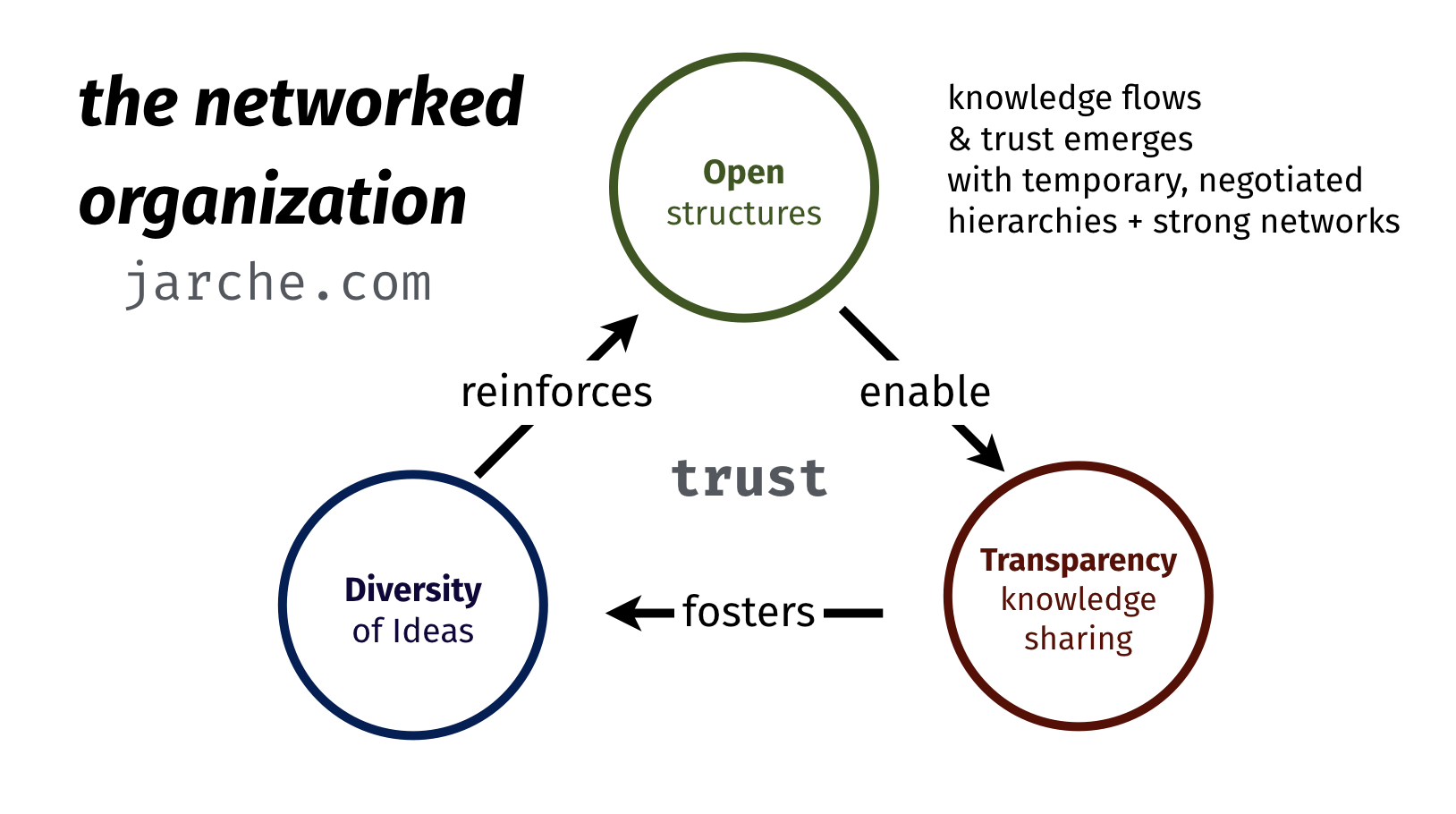
Originally published at Jarche.com
Harold Jarche works with individuals, organizations, and public policy influencers to develop practical ways to improve collaboration, knowledge sharing, and sensemaking.
PLEASE DONATE to help Network Weaver continue in it’s mission to offer free support and resources to networks worldwide.

